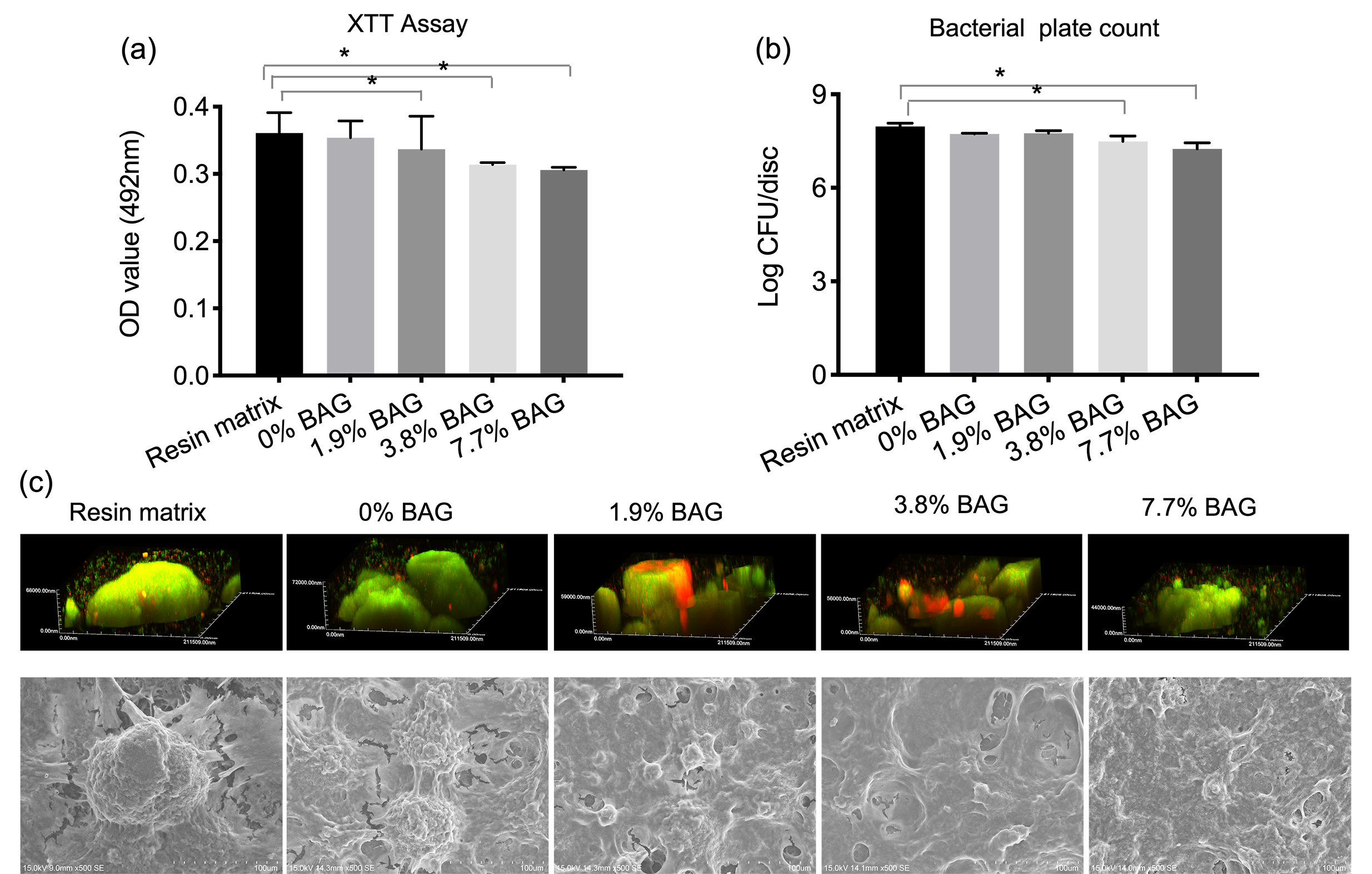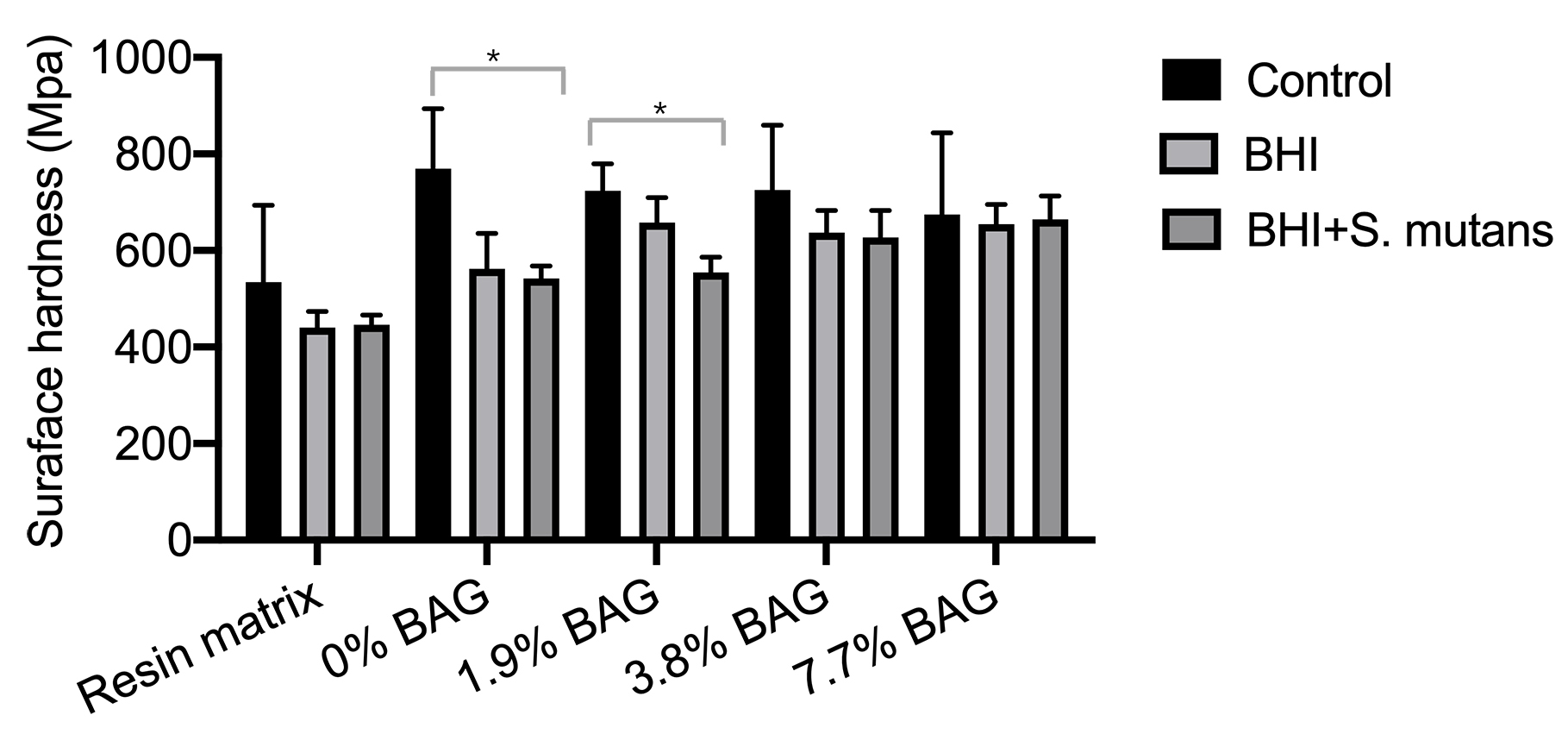IADR Abstract Archives
Antibacterial Activity and Biodegradation of Bioactive Glass-Loaded Resin Composites
Objectives: Resin Composites tend to accumulate thicker biofilm compared with other restorative materials, such that the bacteria would biodegrade the composites. Bioactive glass (BAG) has been shown to suppress bacteria and promote remineralization of teeth. This study aimed to determine whether BAG-loaded resin composites would exhibit both antibacterial and anti-biodegradation properties.
Methods: Experimental UDMA-based resin composites with 25 vol% fillers (containing 0, 1.9, 3.8, and 7.7vol% BAG (45S5 Bioglass) and remaining commercial silanized dental glass filler) were prepared. Each specimen was polished to achieve surface roughness (Ra) of ~0.12 μm by sequential polishing using 600, 1000 and 2500grit SiC-papers under running water. These samples (n=3) were then incubated anaerobically with S. mutans in brain heart infusion (BHI) at 37 °C for 3 days for biofilm maturation. The cell viability was assessed using XTT assays and CFU counting, and CLSM and SEM were used to assess the biofilm formation ability. The biodegradation of resin composites was evaluated via the changes in nanohardness by AFM and additionally using BHI immersion medium as positive control.
Results: The surface roughness of all groups was shown in Table 1. XTT assays revealed that BAG-loaded resin composites had significantly reduced cell viability (Figure 1a), whilst CFU counts (Figure 2b) were decreased with BAG concentration of 3.8% and 7.7%. CLSM revealed noticeable dead/damaged bacterial cells (red staining) on BAG-resin composites, while resin composites with 7.7% BAG had shown a reduced biofilm thickness (44μm) (Figure 1c). Similarly, SEM images demonstrated the formation of large bacteria agglomerates on resin matrix, while the bacteria clumps became smaller with the increase of BAG concentration. BHI immersion did not statistically reduce nanohardness on all samples, but immersion with S mutans caused a statistically significant surface nanohardness reduction on 0% and 1.9% BAG-loaded composites. No biodegradation was found on higher BAG loading (3.8% and 7.7%) composites.
Conclusions: Addition of at least 3.8 vol% bioactive glass might enable antibacterial, reduced biofilm formation, and anti-biodegradation ability in resin composites.
Methods: Experimental UDMA-based resin composites with 25 vol% fillers (containing 0, 1.9, 3.8, and 7.7vol% BAG (45S5 Bioglass) and remaining commercial silanized dental glass filler) were prepared. Each specimen was polished to achieve surface roughness (Ra) of ~0.12 μm by sequential polishing using 600, 1000 and 2500grit SiC-papers under running water. These samples (n=3) were then incubated anaerobically with S. mutans in brain heart infusion (BHI) at 37 °C for 3 days for biofilm maturation. The cell viability was assessed using XTT assays and CFU counting, and CLSM and SEM were used to assess the biofilm formation ability. The biodegradation of resin composites was evaluated via the changes in nanohardness by AFM and additionally using BHI immersion medium as positive control.
Results: The surface roughness of all groups was shown in Table 1. XTT assays revealed that BAG-loaded resin composites had significantly reduced cell viability (Figure 1a), whilst CFU counts (Figure 2b) were decreased with BAG concentration of 3.8% and 7.7%. CLSM revealed noticeable dead/damaged bacterial cells (red staining) on BAG-resin composites, while resin composites with 7.7% BAG had shown a reduced biofilm thickness (44μm) (Figure 1c). Similarly, SEM images demonstrated the formation of large bacteria agglomerates on resin matrix, while the bacteria clumps became smaller with the increase of BAG concentration. BHI immersion did not statistically reduce nanohardness on all samples, but immersion with S mutans caused a statistically significant surface nanohardness reduction on 0% and 1.9% BAG-loaded composites. No biodegradation was found on higher BAG loading (3.8% and 7.7%) composites.
Conclusions: Addition of at least 3.8 vol% bioactive glass might enable antibacterial, reduced biofilm formation, and anti-biodegradation ability in resin composites.


